This is a Spyderco Tactical Knife, but You Should Use it for Other Stuff Too
The Ronin 2 is a good purpose-driven knife. The whole design is centered around the cutting power of the edge. And that was executed well enough that the knife as a whole comes out as an incredibly useful slicer, but that focus does seem to have come at the cost of some comfort and ergonomic issues.
This is one of the first Spydero knives I’ve handled, and the only Michael Janich design I’ve played with so far. I’ve thrown a lot of Janich’s designs into listicles around here because he tends to make practical knives with pretty clear function in mind, which is rare in most knife designs these days.
He has a long history in martial arts that informs all his designs. Through that, he’s developed a Wharncliffe-centric philosophy on the whole thing that I’m not sure I agree with, but I have to admit it’s resulted in some pretty unique knives, and at the end of the day the Ronin 2 is easily one of the top 5 sliciest knives I’ve ever worked with.
Specifications
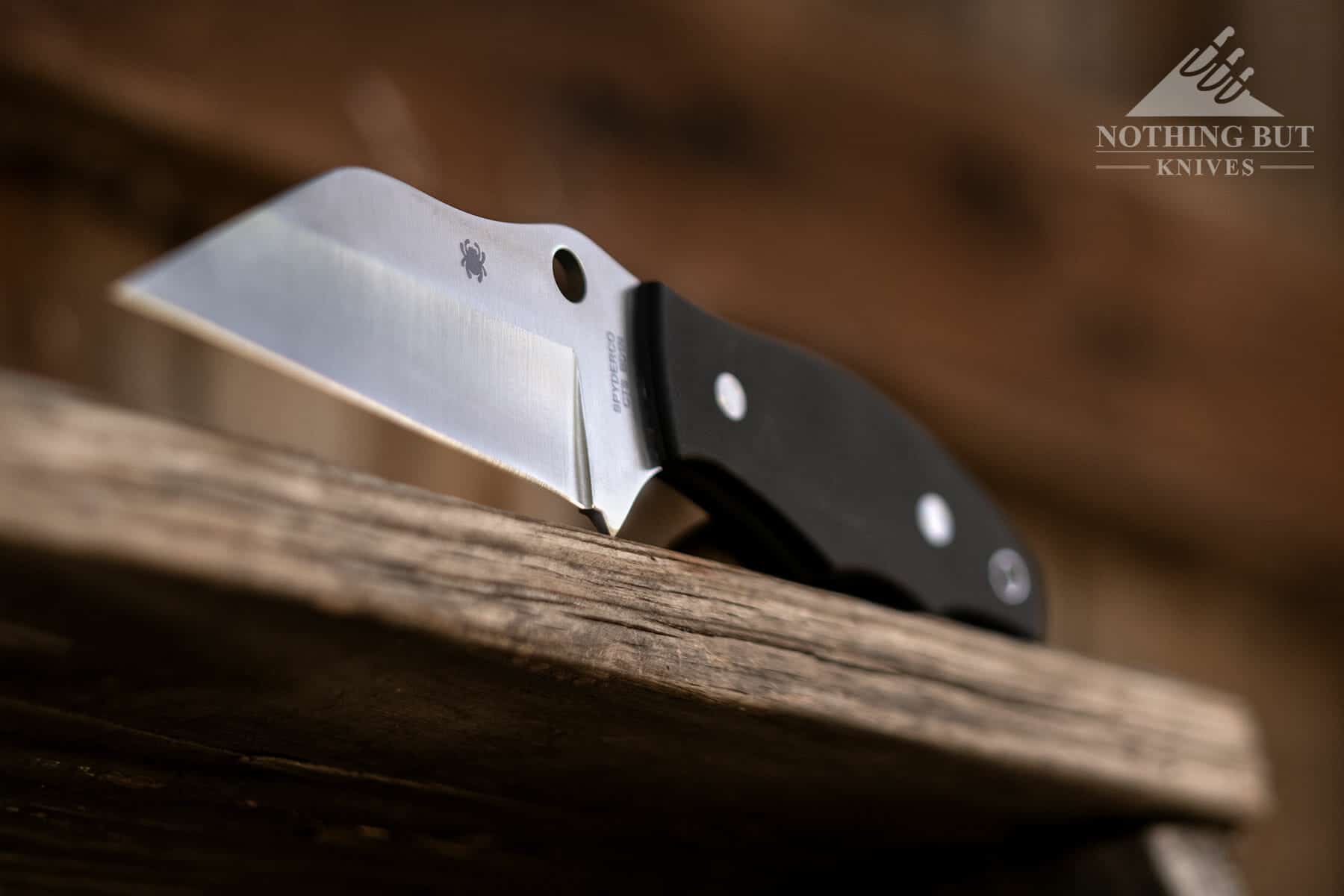
| Overall Length: | 7.875″ |
| Blade Length: | 4.125″ |
| Handle Length: | 3.75″ |
| Blade Steel: | CTS-BD1 |
| Blade Grind: | Hollow |
| Blade Style: | Wharncliffe |
| Handle Material: | G-10 |
| Knife Weight: | 3.765 oz |
| Weight w/ Sheath: | 6.0 oz |
| Sheath: | Boltaron |
| Made in: | Taiwan |
| Price Range: | $110 |
Pros
| Lightweight |
| Horizontal or vertical carry |
| Razor sharp factory edge |
| Tough, practical steel |
Cons
| Thin handle |
| Sheath doesn’t fit a Tek Lok |
| Kinda funny lookin’ |
Bit of Context
The Ronin 2 carries on the namesake of a much smaller tactical design that was intended to be a neck knife. The keen-eyed might notice the Ronin 2’s shape is a lot closer to the Yojimbo 2, though.
Supposedly the design for the Ronin 2 was born from Janich taking the Yojimbo 2 to a seminar and showing it to a custom knife maker, Mickey Yurco, who wasn’t fond of folders. Yurco traced the Yojimbo, made a fixed blade version, then sent it to Janich. After he got the okay to start selling that design, Yurco took it to Blade Show where Eric Glesser saw the design and liked it well enough to put it into production. Thus the Spyderco Ronin 2 was born.
That all kind of begs the question why they didn’t just call this the Yojimbo 3. I guess Janich was just feeling nostagic for his old neck knife design.
Design and Purpose
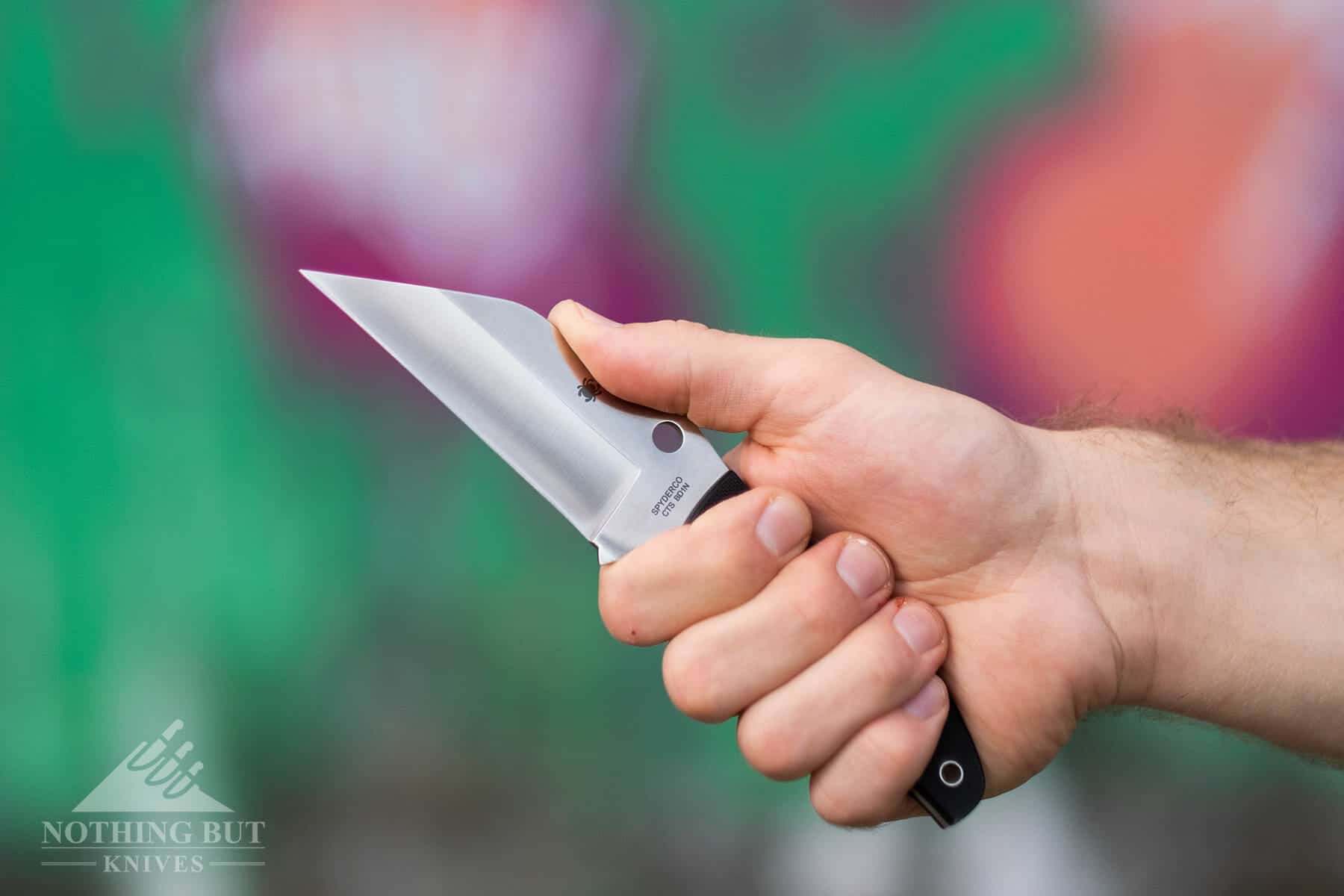
Michael Janich is pretty clear that this is a fighting knife. That’s kind of his thing, and he’s carried a prototype of this around to training seminars just to test it out. The ugly shape of the whole thing is designed for your thumb to rest on the spine and encourage the edge to sit in line with the middle set of knuckles so it’s easier to make more precise cuts.
Apparently he’s partial to the Wharncliffe for combat knives because the way they taper forward at the tip means you can “cut with full power all the way to the point” (as per the Blade Mag article he wrote in 2018). So every inch of the edge gets pretty much the same amount of pressure. After messing around with this, I can see the appeal.
You can do a lot of work with the tip of the Ronin 2 that is a lot harder with knives with bellies or trailing points. If you were only able to cut with the top inch of the edge it would still be very functional.
I don’t personally like the idea of having my thumb stick out like that in a self defense situation, but I’m not about to disagree with someone who’s spent as much time working out the combat applications of this thing as Janich probably has. I’m also not about to go out and test it in that area.
I don’t have a practice version of this knife, and none of my brothers are lining up to let me swing the live blade around at them to check how well it could defend me from the hooligans always trying to take my Lunchables.
Great Edge and Cutting

A couple things I can tell you right off:
- This makes some horrifyingly clean cuts.
- The thumb along the spine thing does seem to help make those cuts more precise.
We had to do several takes on these pictures just to get one where you could see the water spray effect, because so many times the Ronin just left a thin, clean cut on the side.
This knife is damn near surgical. Sharp enough to the point that, no matter what it was designed for in the first place, it has a lot of uses in a lot of different situations. You could use this knife to castrate a bull, if that was the kind of thing you were into doing.
I cut about a dozen ribbons off a piece of paper with this thing before we did our official testing.
The straight edge got in the way of some of the cuts staying clean, but it could just be that I need to get used to cutting with a Wharncliffe, I’ve noticed that it can get a little difficult to keep cutting in a straight line when cutting away from your body. Normally I’d use the belly of a blade to keep a cut going when it gets far from my body, but I can’t really do that with a straight edge.
That goes back to the intention of this thing, though. If it’s really made for fighting, the edge is really only meant to make short, quick cuts. Which is one of the reasons we tested it on water bottles. It really highlights its ability to cut clean as opposed to clunkier knives that mostly cut the bottle open by brute force (the other reason was that we thought it would be fun, and we were right).
Since most people don’t usually need to cut water bottles in half on a day to day basis, here’s how the Ronin 2 did with a bunch of other stuff:
Rope Cutting
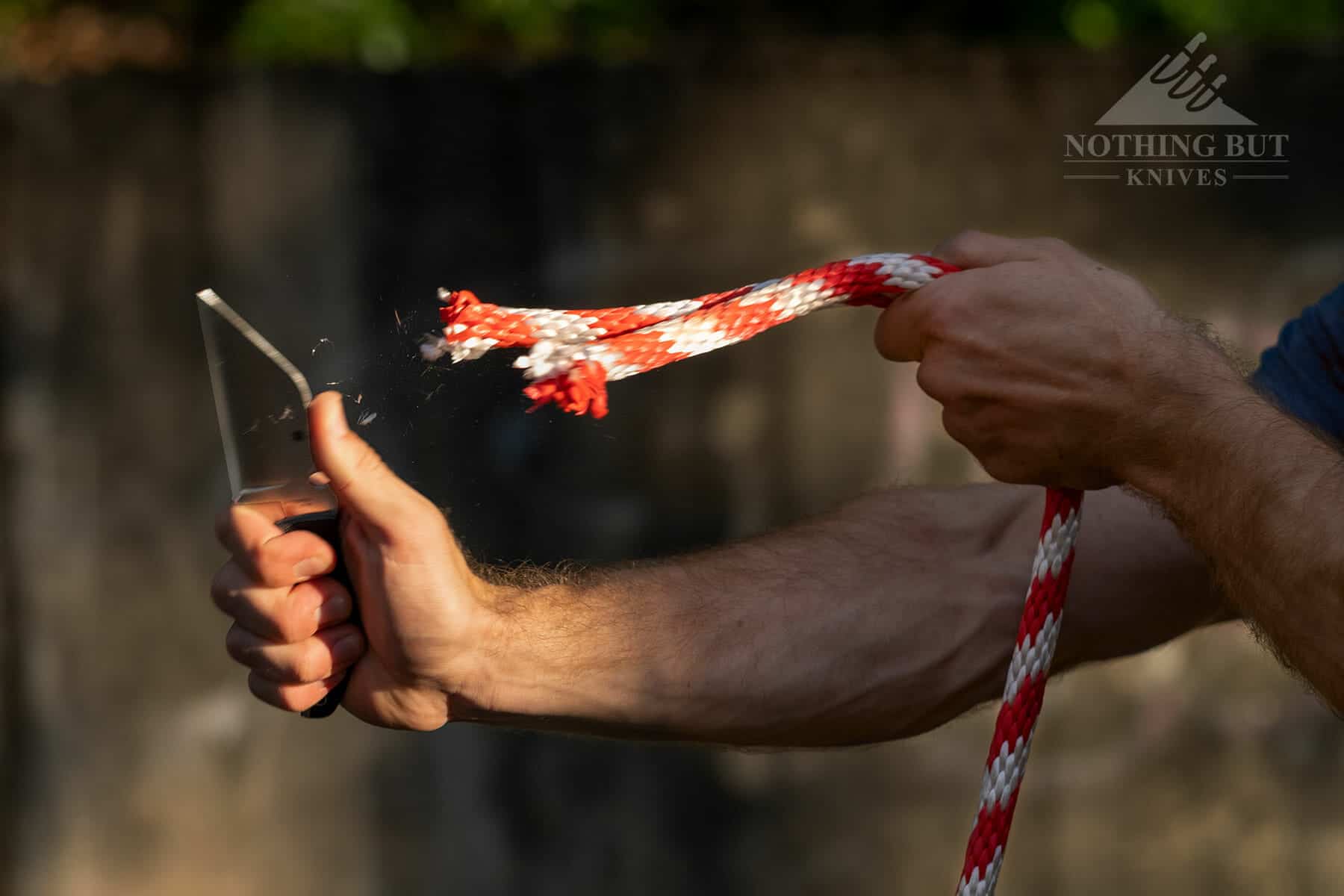
Normally when I test a knife on the rope, I put the edge right up on it with the rope wrapped around and see how much pressure it takes to push the knife through.
With the Ronin 2, it’s not so much about how much pressure it takes to cut the rope as how much of the rope do I want to cut. Almost any amount of pressure will start a cut on paracord. Where normally I’d have to pull and push to sever the rope all at once, the Ronin allows me to ease through at my pace.
Food Prep
It’s not at all what this knife was designed for, but I was curious so I used it to make some crude salsa. It turns out the Ronin does have a bit of utility in cooking. A lot of the best function is near the tip of the blade, so it’s pretty good for coring strawberries and tomatoes. It’s not very good for chopping on a larger scale, at least not compared to a regular chef or utility knife.
That’s mostly because they made the spine so thick it’s hard to cut anything very thin. But it works pretty well on meat and most vegetables, so you could put together a half decent stir fry with this thing.
Edge Retention
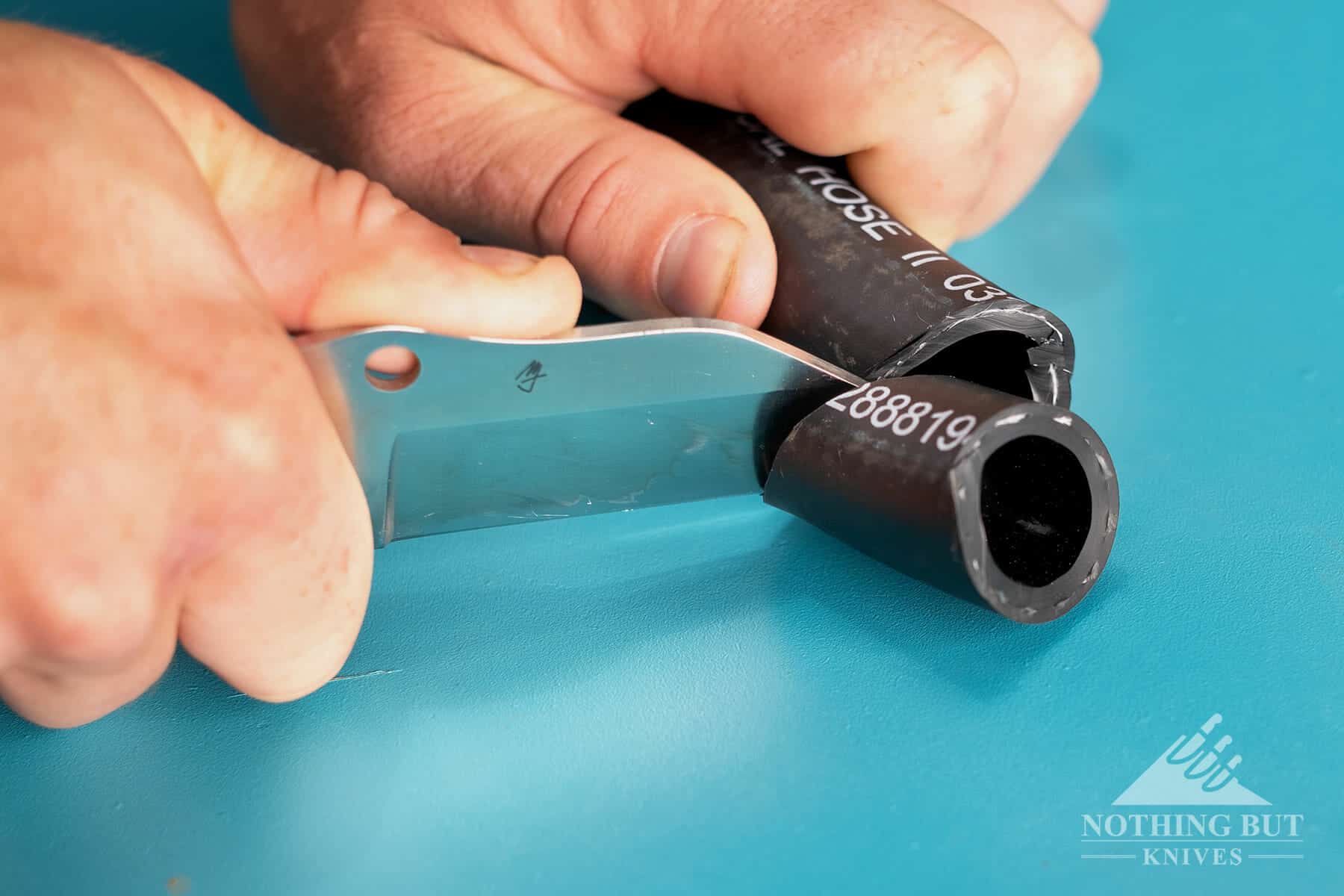
The edge holds up okay. The paper test got a lot rougher after all the testing we did, but I expected that. I’m pretty sure they picked this steel and treated it for toughness over hardness. It just makes sense to use a softer steel with good structure for a knife like this. It takes a sharper edge and maintains the edge structure a lot better, and at the end of the day it usually just needs a bit of stropping to get back into good shape.
They probably could have picked out some kind of super steel that got a little bit of both worlds. But I think if they’d slapped LC200N or Bohler M690 on this thing it would have come out a lot more expensive. As it is, $110 feels feels like a good price for the knife as a whole. So I’ve got no gripes here. They hit right the steel and grind right where they needed to.
Tought Steel with Good Structure
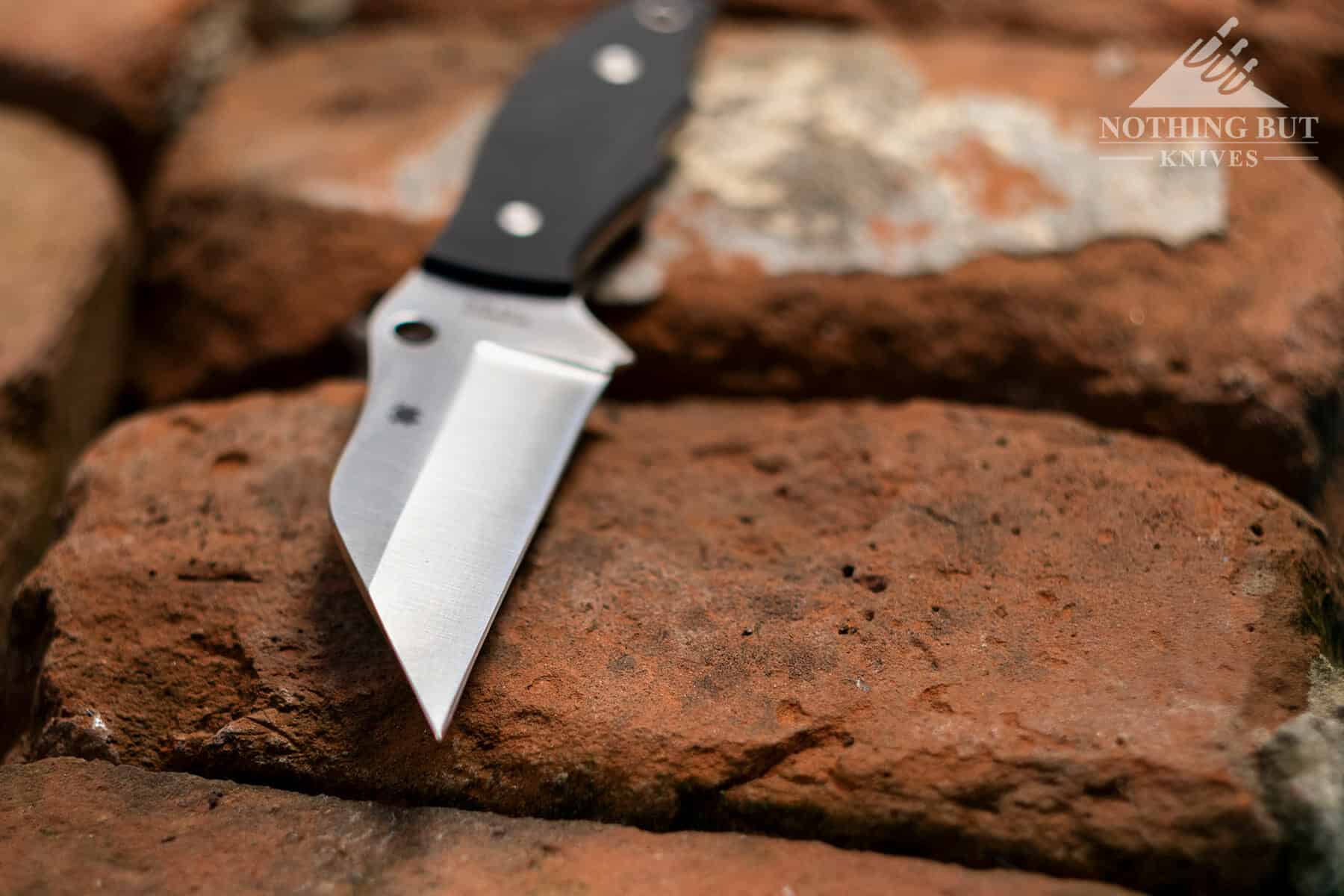
Speaking of steel, the Ronin 2 is sporting something called CTS-BD1N steel. That’s generally considered a mid-range Carpenter steel that’s closest to 440C in comparison. You could say it’s a tougher version of 440C but so much of that kind of thing depends on the heat treatment.
It’s safe to say that Spyderco has a good handle on their treatment, though, so effectively what we have here is a semi-hard steel with really good corrosion resistance and edge stability. Which is to say, it’s close to as hard as you can get in a fighting knife without running a huge risk of chipping the edge all the time.
I’ve got no complaints here, and I definitely like this choice of steel over the S30V used in the Yojimbo 2. This feels like a solid combination of materials with good execution in manufacturing. But that’s to be expected of Spyderco.
Pokey Ergonomics and Comfort
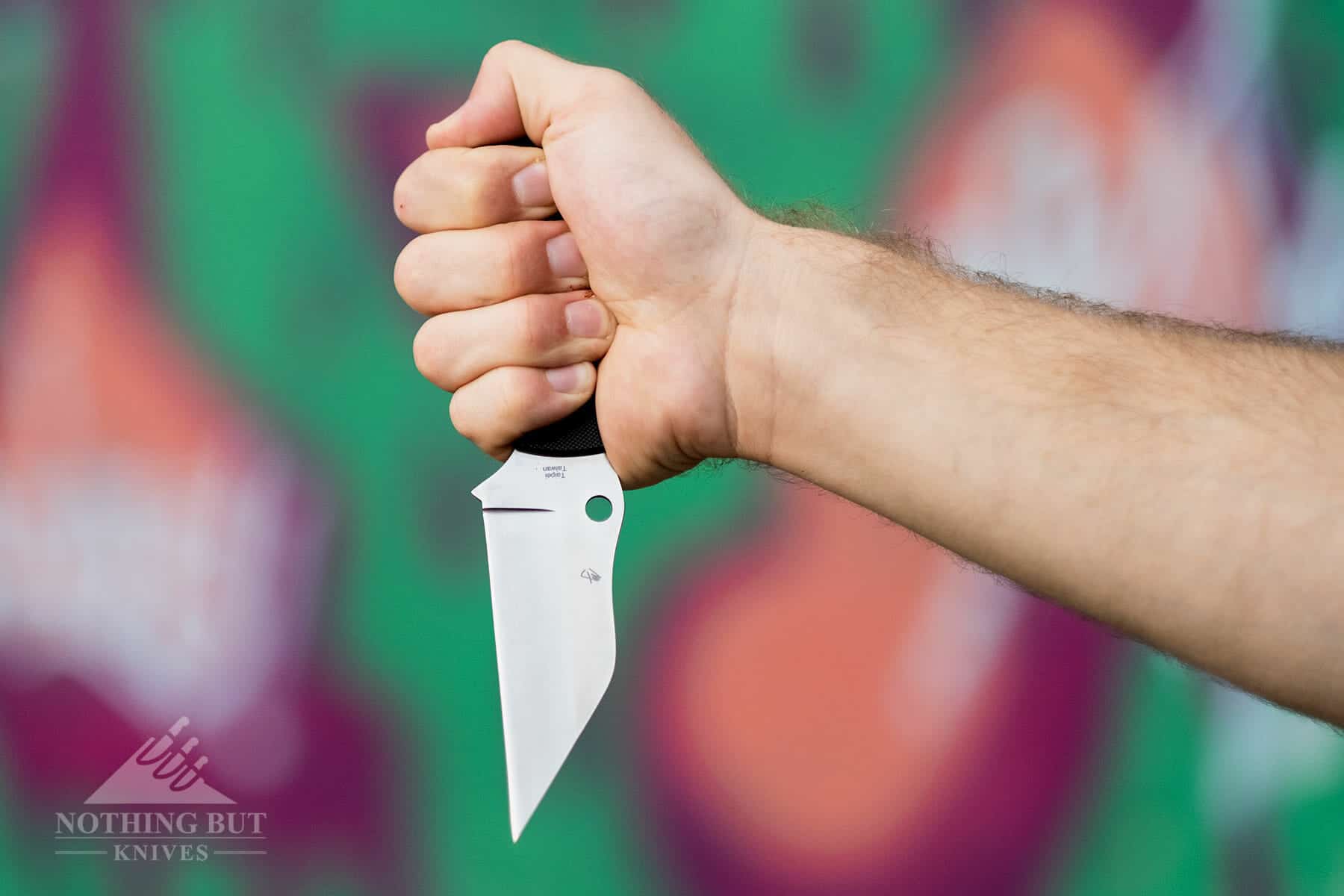
This is where my deeper concerns lie with this knife.
The cutting ability of the Ronin carries the design a long ways, and the thumb along the spine thing does feel pretty nice once you get used to it, but the handle borders on uncomfortably thin. I think the thinness is supposed to make it easier to carry in the sheath, and it certainly does make it lighter, but they could have stood to make the handle a little more inviting.
It might be okay for other people with normal hands, but mine have been put through a lot over the years, and I can feel them stiffening up the longer I hold onto this knife. I’d like to see the G-10 scales just a little wider with some kind of bevel and sloped shape. That would make the grip a lot more pleasant and it would make it easier to change grips.
The finger grooves work pretty well for making the handle grippier, but it makes the grip overall feel kind of weird. I’ve always been a little critical of finger grooves in handles, and these don’t do much to change my mind. It would have been fine if they’d just made that center divot on the handle one smooth slope. That way the hand wouldn’t have so many points to negotiate with, and your fingers would still have a decent bump to grip onto when you’re swinging hard.
The Belt Clip and Horizontal Carry
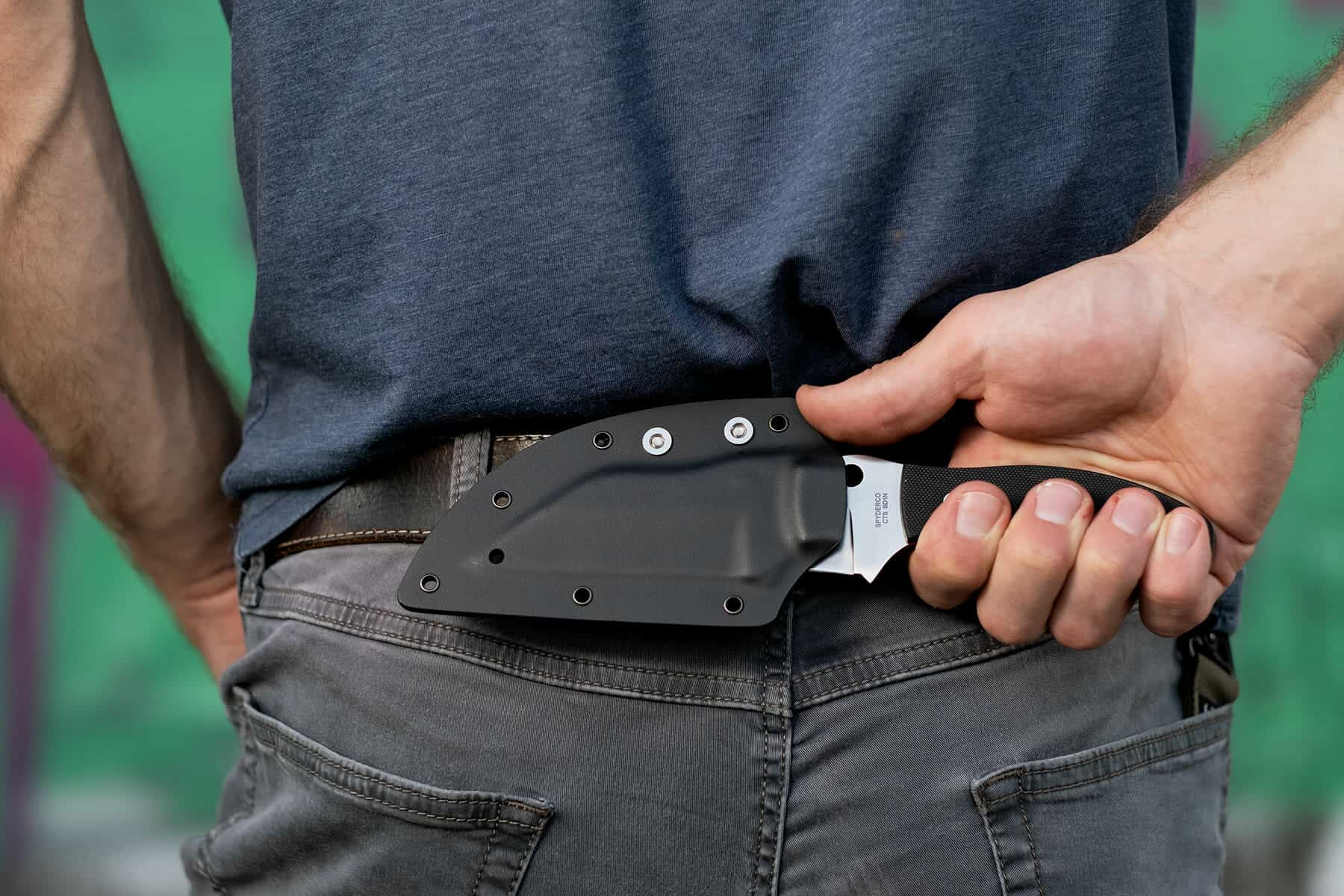
Vertically, this knife rides a little high. But a big reason we picked this knife up was because it could be switched to horizontal carry. It feels okay in scout carry or along the hip (although the handle sticks out quite a bit on me). It’s lightweight and well balanced, but they could use a couple modifications to the sheath over all.
For one thing, the G clip can be a little frustrating to switch around if you don’t have a magnetic torx screwdriver (you’ll need a T8 or T9 torx for this, by the way).
The screws have to drop down through the top part of the loop to rest in the bottom part where you can screw them into the sheath. The first time we did it we must have dropped the screws a half dozen times before we got it all settled. And if you’re doing this in the field, as we often do when we test knives, that risk of losing a screw gets very high.
That’s part of the beast with a lot of belt clips, though. My real gripe is with the way they’ve punched holes in the sheath for the a clip, because (1) these aren’t quite wide enough apart to fit a Tek Lok, and (2) there are only two holes the clip can be fitted onto.
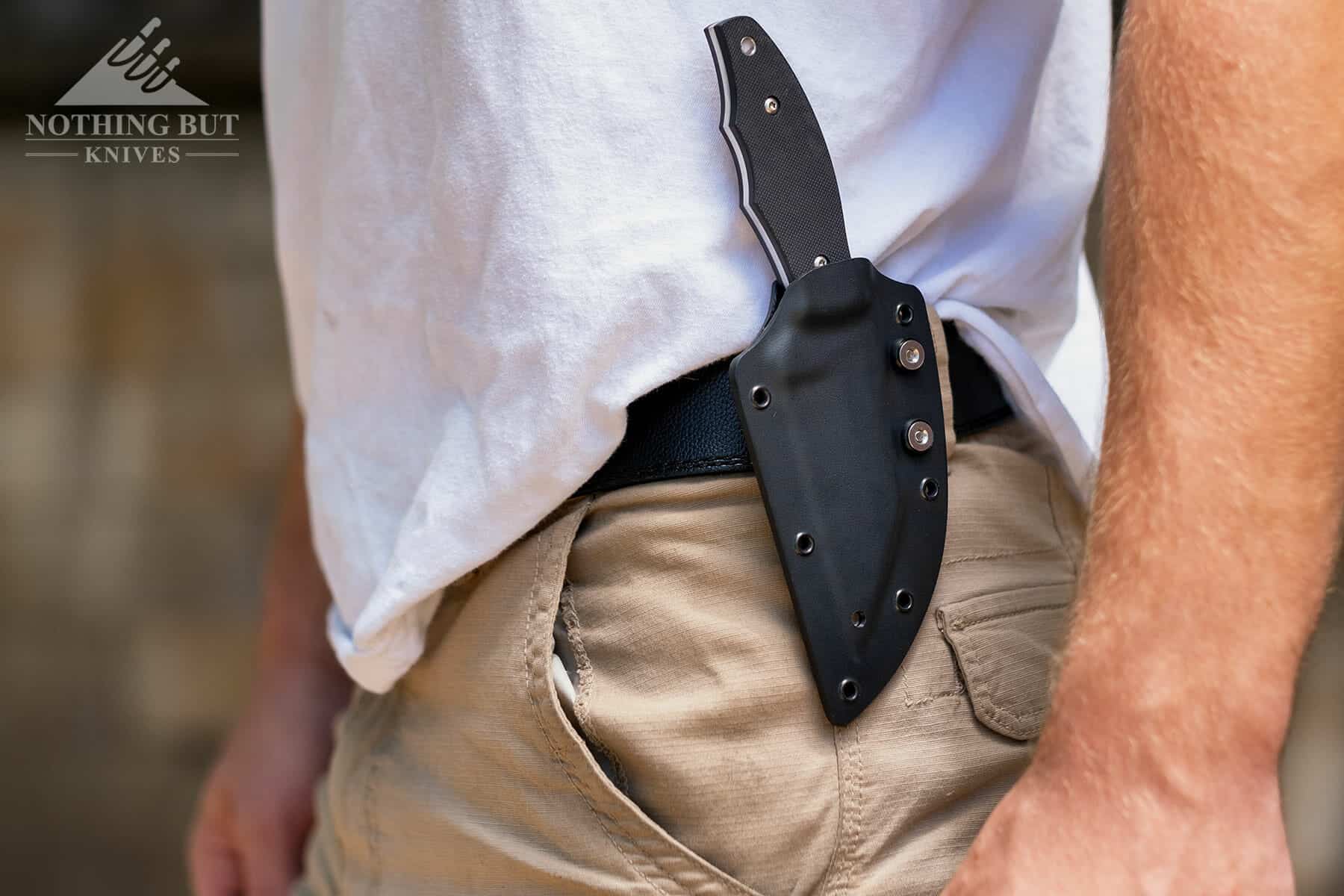
This puts some pretty big limitations on how you can carry this knife. I could almost forgive the sheath not fitting with a Tek Lok if they’d given me a few more options with what angle the belt clip sits at. That way I could play around with making the draw quicker and more comfortable by adjusting how it sits around whatever I’m wearing.
And really, what is the excuse for making this incompatible with a Tek Lok?
Maybe that’s not a fair complaint, though. With most sheaths you get one carry option. It’s vertical or nothing and you just have to take the punch to the rib if you want to walk around with it on your belt. The Ronin 2 is at least designed well enough that scout carry with just the stock equipment carries decent.
It just feels like it could have been a lot better with a little extra effort (by the way, this is not the first time I’ve whined about the sheath on an otherwise well-made knife).
Comparison and Alternatives
I haven’t handled too many knives like this, so it’s hard to come up with decent alternatives.
One good place to look, though, is within Janich’s circle of designer friends, mainly Fred Perrin (knives by Mike Snody and Mickey Yurco are harder to find since they aren’t as prolific as they used to be).
The Fred Perrin Le Shark or Le Bowie both offer similar hand ergonomics and edge philosophy, and even have similar price points. The carry options will be a little different thoughm especially with the Shark.
For cheaper urban carries, I’d say the Ka Bar TDI and the CRKT S.P.E.W would be worth considering. You can get both with Wharncliffe blades, they’re a lot smaller, cost quite a bit less, and are easier to conceal, if that’s what you want. The blade material and edge aren’t up to par with the Ronin 2, though.
The Ka Bar TDI Hinderance should be a serious consideration as well. It’s very similar in style and purpose, with some of Rick Hinderer’s ergonomic genius behind it. They’re almost in the same price range (the TDI Hinderance is usually about $80), and they both have a Wharncliffe blade with a thumb groove. You’re not getting that Spyderco edge with the TDI Hinderance, but you are getting Ka Bar’s 1095 Cro-Van steel.
There’s also the ESEE Gibson Pinch Neck Knife, if you want to go even smaller, but that’s getting pretty far out of the scope of uses that the Ronin 2 covers.
Conclusion
This knife set out to be something, and I think it hit all the points it needed to in order to be that thing. It’s held back mostly by the thin handle and the sheath, but those are easy to change out if you like the design well enough. Down the road I might throw some custom scales on it to make it more comfortable for me, and a custom sheath is almost certainly in this knife’s future.
But taken as a whole, the Ronin 2 comes out of the box ready to shave hair and get tossed around. It’s unique and highly functional.
Even if self defense isn’t a concern, the Ronin 2 comes in handy for everything from box cutting to light food prep. I’d even go so far as to say that I like this knife. Not as much as I like the bushcraft knives we’re more used to testing, but it’s hard to not love a knife a little bit after you’ve cut a water bottle clean in half with it.

Hi Andrew,
Great review! I’m now keen on getting one but would like to ask where you were able to get thicker handles?
Thanks!
Hi Paul, thanks for reading.
I spoke too soon in this review, it turns out. I saw a lot of people selling third party scales for the Yojimbo 2 and assumed it would be a simple thing to find the same for the Ronin 2, but no such luck.
As of right now, I think the best option for getting thicker scales on the Ronin 2 is to find someone who does custom work and ask if they can do a special order. Otherwise, if you don’t mind going with a folder, there are third party scales all over places like Etsy and BladeHQ for the Yojimbo 2. You could also check out companies like Flytanium. They have some pretty good stuff for a lot of different designs (just not the Ronin 2).